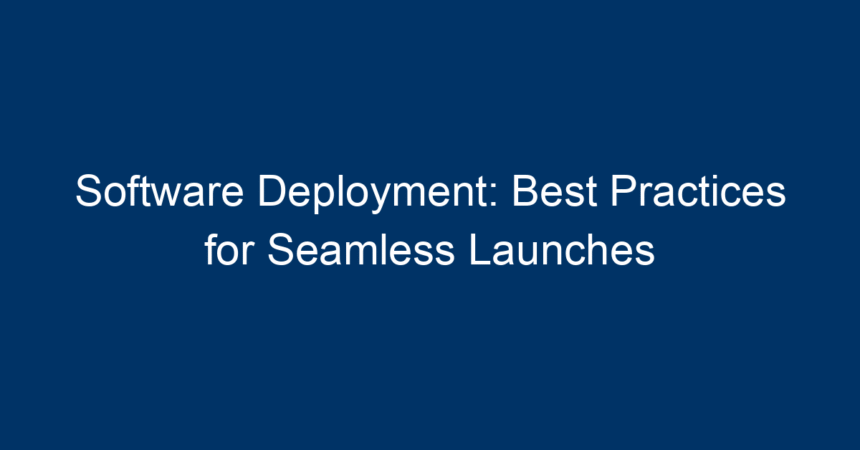In today’s fast-paced technological landscape, the success of any software product largely hinges on its deployment process. A smooth software deployment not only enhances user experience but also ensures that the development team’s hard work pays off effectively. But, what exactly is software deployment? It encompasses all the steps and processes involved in making a software application operational for end-users. This article delves into best practices for software deployment, giving you actionable insights for seamless launches.
Understanding Software Deployment
Before diving into best practices, it’s essential to grasp the fundamental concepts of software deployment. Software deployment includes planning, scheduling, testing, and launching the software application in a live environment. It varies based on the size and complexity of the application—ranging from simple updates to comprehensive system installations.
Types of Software Deployment
-
Automated Deployment: Utilizing CI/CD tools to automate deployment processes, minimizing human error.
-
Manual Deployment: Involves manually executing deployment steps, which can be prone to mistakes and is usually time-consuming.
-
Cloud Deployment: Deploying applications on cloud platforms (like AWS, Azure) is increasingly popular due to scalability and cost-efficiency.
- On-Premise Deployment: Installing software directly on company-owned servers, offering higher control over security.
Understanding these types can help you determine which method is best suited for your specific software deployment needs.
Best Practices for Software Deployment
1. Planning and Documentation
One of the first steps to successful software deployment is meticulous planning and documentation. Outline every step involved in the deployment process, including roles and responsibilities, timelines, and milestones.
- Key Subtasks:
- Identify stakeholders.
- Establish a timeline.
- Document the deployment process in detail.
Effective documentation can serve as a reference point, guiding teams through the deployment process and minimizing misunderstandings.
2. Automate Where Possible
Automation is crucial in modern software deployment. Employ Continuous Integration/Continuous Deployment (CI/CD) tools to streamline your deployment process.
- Benefits of Automation:
- Reduces human error.
- Increases deployment speed.
- Enhances consistency across deployments.
Popular CI/CD tools like Jenkins, GitLab CI, and CircleCI can radically transform how you manage software deployment.
3. Environment Consistency
Ensure that your development, testing, and production environments are as similar as possible. Discrepancies can lead to unexpected behavior post-deployment.
- Utilize Containers:
- Tools like Docker can create consistent environments, reducing the chances of deploy-time failures.
Implementing Infrastructure as Code (IaC) practices can further ensure that your environment replicability is both reliable and efficient.
4. Conduct Thorough Testing
Before deploying your software, it’s imperative to conduct extensive testing. This phase should include:
- Unit Testing: Validating individual components for expected functionality.
- Integration Testing: Ensuring different modules work together seamlessly.
- User Acceptance Testing (UAT): Involving actual users to test the system in a real-time environment.
Automated testing can help speed up this process, letting the development team focus on fixing identified issues swiftly.
5. Implement a Rollback Strategy
Despite thorough testing, unforeseen issues may arise post-deployment. Having a rollback strategy ensures that you can revert to a previous version of the software if necessary.
- Rollback Strategies:
- Point-in-time backups.
- Version control with easy rollback capabilities.
A clear rollback plan is essential for minimizing downtime and maintaining user trust.
6. Monitor and Measure Performance
Once the software has been deployed, continuous monitoring is crucial to ensure it functions as intended. Utilize performance monitoring tools to track:
- Application performance
- User engagement
- Error logs
Analytics will help you identify areas for improvement, guiding future updates and deployments.
7. Documentation and User Training
It’s not enough to deploy software; stakeholders need to understand how to utilize it effectively. Comprehensive user training and documentation can bridge this gap.
- Best Practices:
- Create help guides and tutorials.
- Offer training sessions for users.
Effective documentation improves user adoption and satisfaction, making a seamless transition to the newly deployed software.
8. Gather User Feedback
Post-deployment, engage with users to gather feedback. It’s vital for understanding their experiences and uncovering potential issues that may not have been identified during testing.
- Methods for Gathering Feedback:
- Surveys
- User interviews
- Feedback forms
Incorporate this feedback into your next deployment cycle to improve the application continually.
Key Challenges in Software Deployment
While implementing best practices is crucial, being aware of potential challenges can help you prepare better:
- Technical Debt: Accumulating unresolved technical issues can complicate deployments.
- Lack of Communication: Poor communication among team members can lead to chaos.
- Time Constraints: Rushing the deployment process often leads to mistakes.
Recognizing these challenges allows you to devise strategies to mitigate them, ensuring a more streamlined deployment process.
Conclusion: Actionable Insights for Seamless Software Deployment
Software deployment is not merely a phase in the software development lifecycle; it’s a crucial step that can significantly impact user experience and business success. Implementing best practices like thorough planning, automation, consistent environments, rigorous testing, and continual monitoring will pave the way for seamless software launches.
As you prepare for your next software deployment, remember:
- Prioritize detailed planning and documentation.
- Automate processes with CI/CD tools.
- Conduct extensive testing.
- Establish monitoring and rollback strategies.
- Always gather user feedback for future improvements.
By adhering to these best practices, you’ll ensure that your software deployments are not only successful but also a driving force for organizational growth and user satisfaction. Embrace these strategies to transform your next software deployment into a seamless experience that delights users and fosters innovation.




